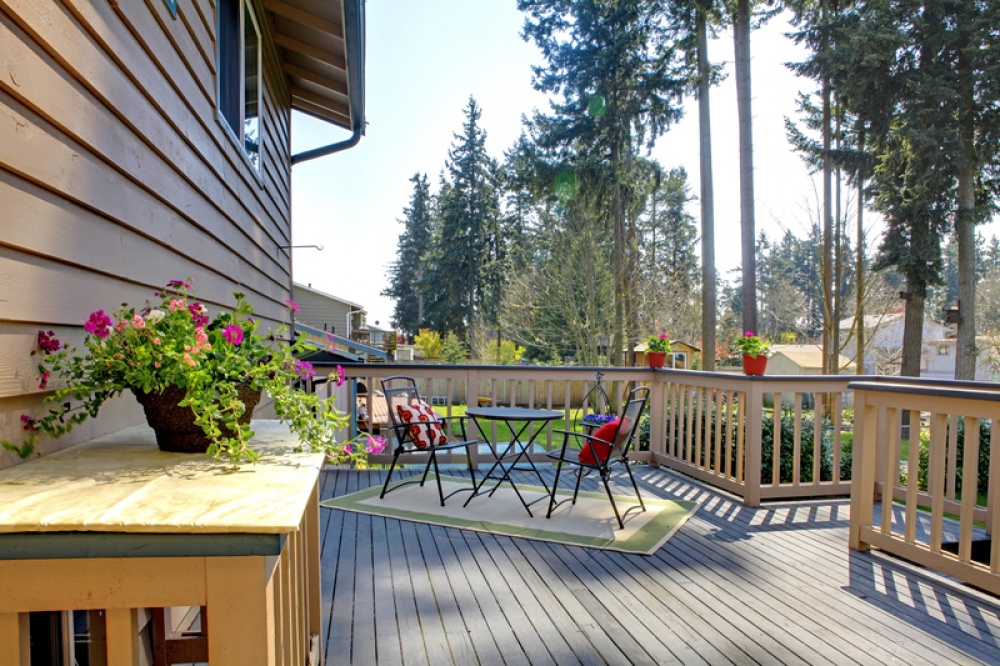Decked Out

Decking has been popular as a means of extending space but it does require upkeep to make sure it looks good and stays safe. Now, there is a smart looking low-maintenance alternative. Living North talks to expert Adrian Smith to find out more
‘That’s why we are constantly asked for ideas that will cut down on garden maintenance so that people can enjoy their leisure time and their gardens. This subject came to mind recently when my wife’s business partner turned up at work with his wrist strapped and out of use. He had slipped on the decking outside his house and in the resultant fall had damaged his wrist. This can be a big problem if wooden decking is not regularly cleaned and treated. It is incredible how slippery wet wood can be, particularly if you add a little algae or some wet leaves.’
Many people blame Alan Titchmarsh and the Ground Force team for the proliferation of garden decking in the 1990s, but that is a little unfair. Decking has been around for some time. In Scandinavia, houses often traditionally had a balcony built which was raised above the sloping ground to increase the useable area. In America’s Wild West, it was common to have wooden walkways in front of buildings to keep pedestrians out of the mud, and worse. These ‘boardwalks’ were the precursor to the garden decking we know, and now sometimes dislike. The original ‘decks’ were commonly made from redwood or cedar, but with increased forest production and pressure treatments, cheap available softwood became the price-driven choice for garden deck boards. Thanks to the popularity of garden makeover programs on TV, demand grew and DIY stores and landscapers were happy to fill that demand with pine decking.
Pine decking is perfectly serviceable and relatively cheap, but it does need regular maintenance, which is the bit that we hate and the reason decking has gained its bad reputation. It should be cleaned every year and painted or treated at least every two years to ensure it is safe to walk on, even when it is raining. What usually happens however, is that the wood is left untreated, absorbing quite a lot of water. This creates a perfect environment for fungus and algae to grow, resulting in a very slippery surface and the start of terminal decay. Without maintenance even pressure-treated soft wood can rot within five to seven years.
‘In my view, decking has received a slightly undeserved fall from grace,’ says Adrian. ‘It is now thought of as a bit naff, but sometimes it can be the only solution to some of the problems we encounter in the garden. There will often be a drop from the floor level of the house to the ground and sometimes the damp course level will preclude the option to build up the ground next to the house. In these instances, if you want to retain the floor level out into the garden the only option is to build up and deck the area. On very steep gardens it is a great way to gain a flat surface for table and chairs without having to move large quantities of earth, which gets pretty expensive.’
So let’s assume a deck is the right choice for your garden. How can you minimise the time required to keep it clean and safe? Hardwood is better than softwood but still requires some protection. Alternatively, there are two types of man-made planks that require no treatment and will outlast even hardwood without any hassle. These are pretty good environmentally, as well as both using recycled waste plastics. KLP or zyplex are 100 percent recycled plastic that is moulded into textured deck boards and other useful profiles. It is generally black in colour, although other colours are available at a little extra cost. Prices are equivalent to hardwood but it requires no maintenance other than cleaning. It is completely water-resistant and gives excellent slip resistance even when it is raining. It is the perfect building product for the garden as it is rot-proof, so even when laid on or in the wet ground it will last indefinitely. It is now used in many conservation areas and waterways as it is non-toxic and inert. Designed for commercial use it may not be to everyone’s taste but it is unbeatable when it comes to resilience. You will almost certainly have seen it made into picnic benches, piers or even bridges.
The second product is a composite board made from waste plastics and wood waste that is mixed together and formed into planks (a bit like MDF, but water-proof), often with a hollow section that makes them a little lighter to use than the solid plastic ones. It is also contoured to allow for a clever blind fixing to locate into the side of the plank and give a very sleek and contemporary finish with no visible fixtures. It comes in brown, grey and black and is similarly priced. Invented by an American company, it is now made all over the world under different names such as Tex or Saige. Finish it with a stainless steel wire surround or glass panels and you will have a deck for the 21st century that will wow the neighbours and may well last into the 22nd century.
Adrian Smith, Patio & Paving www.patioandpavingcentre.co.uk




